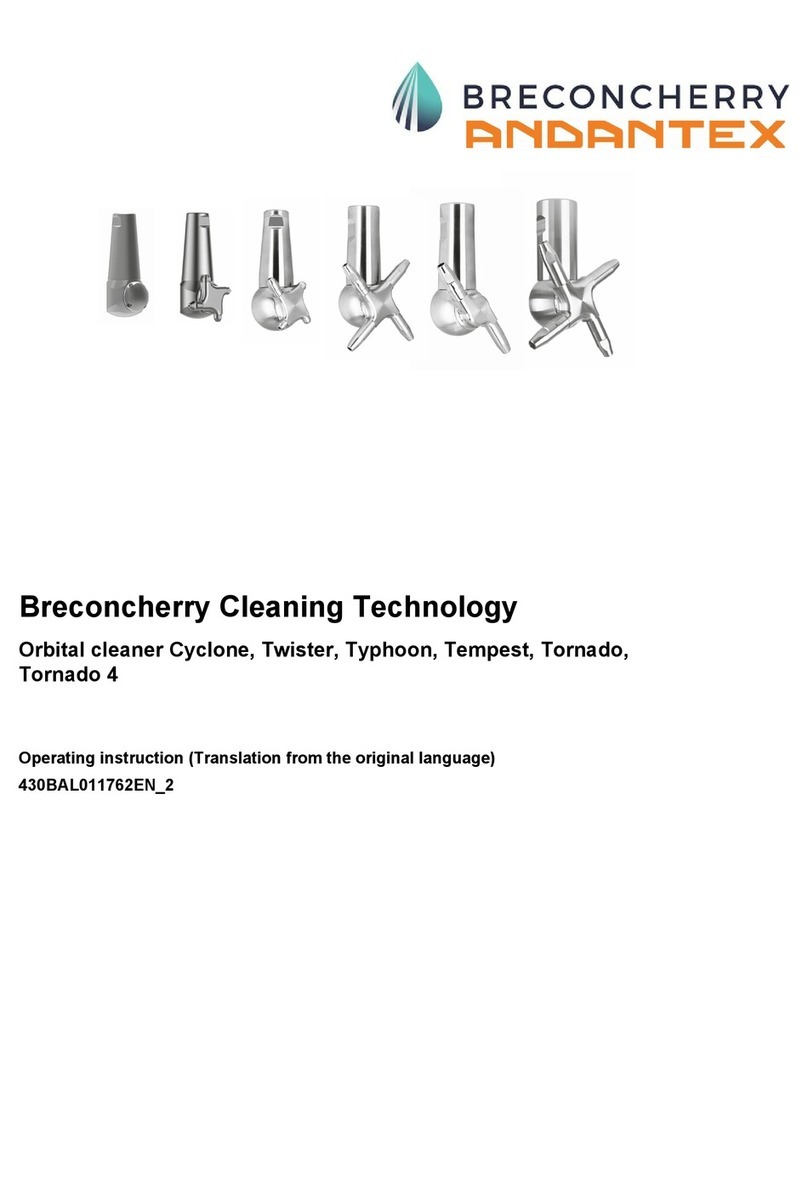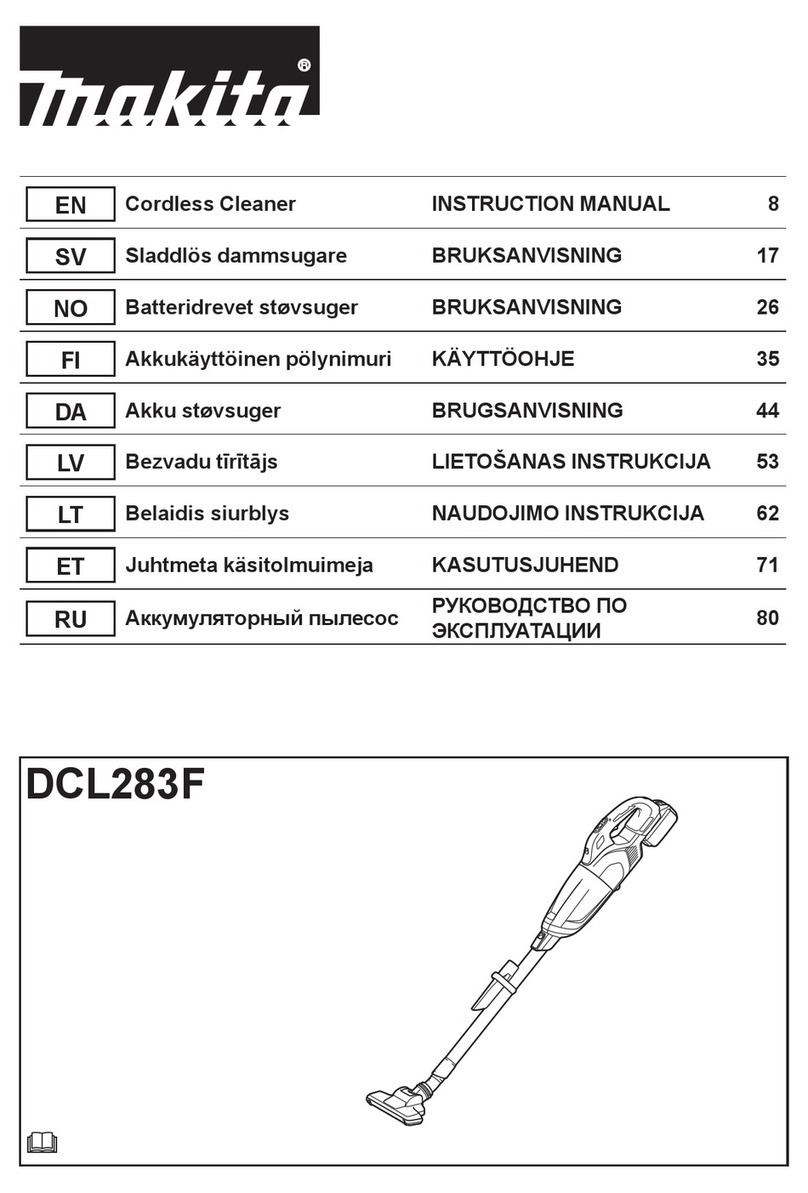Breconcherry Planetary Gear Stainless Steel User manual

Breconcherry Cleaning Technology
Cleaner ATEX Version
Operating instruction (Translation from the original language)
430BAL011767EN_3

COPYRIGHT
These Operating Instructions are the English translation of the original operating
instructions in the sense of the EU Machinery Directive. This document is
protected by copyright. All rights reserved. The document may not, in whole or in
part, be copied, reproduced, translated or reduced to an electronic medium of
machine-readable form without the express permission of Breconcherry.
LEGAL NOTICE
_
We kindly request that you answer a few short questions about these Operating
Instructions. Use the following QR code or link to access the questionnaire:
https://www.ntgt.de/ra/s.aspx?s=367112X57707125X58087
430BAL011767EN_3
2 28.05.2018

TABLE OF CONTENTS
1 General Information 5
1.1 Information about this document 5
1.1.1 Binding Character of These Operating Instructions 5
1.1.2 Validity of the Instruction manual 5
1.2 Manufacturer address 5
1.3 Contact 5
1.4 Marking 6
2 Safety 8
2.1 Intended use 8
2.1.1 Requirements for operation 8
2.1.2 Improper operating conditions 8
2.2 Safety notes 8
2.3 Operating Conditions 10
2.3.1 Temperature 10
2.3.2 Pressure 11
2.3.3 Flow volume 11
3 Declaration of Conformity 14
4 Cleaning 15
4.1 The cleaning of the tanks in explosive atmospheres 15
4.1.1 Basics 15
4.1.2 Guidelines 15
4.2 Selection of the cleaning parameters according to TRGS 727:2016 16
4.2.1 Cleaning with water jets with pressures of up to 12 bar 16
4.2.2 Clean with solvents of low and medium conductivity from pressures up to 12 bar 16
5 Maintenance 17
5.1 Putting cleaner in the tank - mechanically generated sparks 17
5.2 Manhole cover 17
5.3 Electric functions 17
5.4 Grounding - electrical load 17
5.5 Filling the tanks 18
5.6 Inerting 18
5.7 Foreign material in the fluids. 18
5.8 Petroleum vehicles 18
5.9 Maintenance / servicing 18
5.9.1 Authorized personnel / OEM replacement parts 18
5.9.2 Maintenance 18
5.10 Flow and operational parameter monitoring for orbital cleaners 19
6 Additional information on cleaner selection 20
6.1 Possibilities of ATEX classification 20
6.1.1 Cleaner with its own potential ignition source 20
6.1.2 Additional restrictions on usable substances 21
6.2 Instructions for the operation of the cleaner 21
6.3 Explosion groups 21
6.4 Substance classification 21
7 Further information sources 22
8 Appendix 23
8.1 Lists 23
8.1.1 Abbreviations and terms 23
430BAL011767EN_3
28.05.2018 3

430BAL011767EN_3
4 28.05.2018

1 General Information
1.1 Information about this document
The present Operating Instructions are part of the user information for the
component.
1.1.1 Binding Character of These Operating Instructions
These Operating Instructions contain the manufacturer's instructions to the
operator of the product and to all persons who work on or use the product
regarding the procedures to follow.
Carefully read these Operating Instructions before starting any work on or using
the product. Your personal safety and the safety of the product can only be
ensured if you act as described in the Operating Instructions.
Store the Operating Instructions in such a way that they are accessible to the
operator and the operating staff during the entire life cycle of the product. When
the location is changed or the product is sold make sure you also provide the
Operating Instructions.
1.1.2 Validity of the Instruction manual
The instruction manual is valid exclusively for the cleaner marked with an ATEX
marking.
The approved cleaners are suitable for operation in potentially explosive
atmospheres, taking into account the relevant regulations and the manufacturer's
declaration or declaration of conformity.
Use in potentially explosive atmospheres must be specified when ordering, as the
ATEX cleaners are slightly modified and labelled.
Their conformity, and therefore, their suitability for the intended purpose with
regard to the safety of the product in which they are installed must be assessed
in the conformity assessment of the entire product.
The ATEX version of the cleaner may only be safely used in hazardous areas for
the intended area. This manual contains basic instructions for the use of the
cleaner in potentially explosive atmospheres. This document is a supplement to
the general standard operating instructions for the cleaner and is therefore to be
considered part of it. These additional operating instructions must be observed
before installation and commissioning. The operating instructions must always be
available at the cleaner/system site.
1.2 Manufacturer address
1.3 Contact
Phone:+44 (0)1531 632476
Fax: +44 (0)1531 633839
General Information
Information about this document
430BAL011767EN_3
28.05.2018 5
Breconcherry Ltd
Westfalia House, Old Wolverton Road
Milton Keynes, MK12 5PY, United Kingdom

Mail: [email protected] Web: http://
www.breconcherry.com
1.4 Marking
The orbital cleaners have a labelling on the lower rotating body. The following
data is available depending on the material being used.
Planetary gear stainless steel
Logo
Fig.1
Short Name I.e. Ty TSG 4.5mm CPTFE 1"BSP"
Comes from: Type, i.e. Ty, Variants, i.e., TSG, Nozzle bore, i.e. 4.5mm, Bearing
materials, i.e. C-PTFE, connections, i.e. 1"BSP
Material number / Year of Manufacture e.i. 4660-4969-117 YOC2018
Serial number i.e. SN 1435882-0010-001
ATEX labelling
Fig.2 Fig.3
II 1G Ex h IIC T3..T6 Ga
0°C ≤ Ta ≤ 140°C
Fig.4 Fig.5
II 1D Ex h IIIC T140 °C Da
0°C ≤ Ta ≤ 140°C
Certification number: TPS 18 ATEX 22040 001 X
Address Breconcherry Ltd
Westfalia House, Old Wolverton Road Milton
Keynes, MK12 5PY, United Kingdom
General Information
Marking
430BAL011767EN_3
6 28.05.2018

Planetary gear PEEK
Logo
Fig.6
Short Name i.e. Ty TSG 4.5mm CPTFE/PEEK 1"BSP"
Comes from: Type, i.e. Ty, Variants, i.e., TSG, Nozzle bore, i.e. 4.5mm, bearing
materials, i.e. C-PTFE, connections, i.e. PEEK. Connection, i.e. 1”BSP
Material number / Year of Manufacture e.i. 4660-4969-130 YOC2018
Serial number i.e. SN 1435883-0010-001
ATEX labelling
Fig.7 Fig.8
Typhoon, Tempest,
Tornado, Tornado 4:
II 1G Ex h IIB T3..T6 Ga
II 1D Ex h IIIC T140°C Da
0°C ≤ Ta ≤ 140°C
Fig.9 Fig.10
Cyclone, Twister:
II 1G Ex h IIC T3...T6 Ga
II 1D Ex h IIIC T140°C Da
0°C ≤ Ta ≤ 140°C
Certification number: TPS 18 ATEX 22040 001 X
Address
Fig.11
General Information
430BAL011767EN_3
28.05.2018 7
Breconcherry Ltd
Westfalia House, Old Wolverton Road Milton
Keynes, MK12 5PY, United Kingdom

2 Safety
2.1 Intended use
The cleaner is intended for the cleaning of tanks and vessels. This cleaner was
designed for the installation and operation at any angle. Using the device for any
other purpose is considered contrary to its designated use.
The cleaner is intended only for operation with supply of liquid medium. Exposure
to air, other gaseous media or steam is also not permitted, even for a short time.
Hint!
The manufacturer will not accept any liability for damage resulting
from any use of the cleaner which is not in accordance with its
designated use. The risk of such misuse lies entirely with the operator
of the facility.
2.1.1 Requirements for operation
The prerequisite for reliable and safe operation of the component is proper
transportation and storage as well as professional installation and assembly.
Operating the unit within the limits of its designated use also involves adhering to
the operating, inspection and maintenance instructions.
2.1.2 Improper operating conditions
The operational reliability of the cleaner cannot be ensured under improper
operating conditions. Therefore avoid improper operating conditions.
Operating the cleaner is not permitted if
•Persons or objects are in the danger zone.
•Safety devices are not working or were removed.
•Malfunctions have been detected on the cleaner.
•Damage has been detected on the cleaner.
•Maintenance intervals have been exceeded.
2.2 Safety notes
Please heed the following notes
•Conformity applies only to cleaners without electrical components.
•Before putting the cleaner into operation, make sure that nobody can be
endangered by the cleaner’s running.
•Never operate the cleaner outside the object to be cleaned.
•Rotating parts and spilled cleaning fluid can endanger people and cause
property damage.
•The cleaners may only be operated if cleaning fluid is supplied. For the orbital
cleaners, flow control with a time-delayed start-up must be ensured by the
operator (see chapter "Flow monitoring", section 5.10, page 20).
Safety
Intended use
430BAL011767EN_3
8 28.05.2018

•The cleaner must not be exposed to gas and vapour instead of liquid, not
even briefly when starting the cleaning process and emptying pipes. High
speeds and increased friction could cause damage and ignition hazards.
•The cleaners must be filled with cleaning fluid without pressure and then
started gently. Filling under pressure would amount to a short-term operation
with gas or vapour, which can lead to ignition hazards. A sudden start can
lead to damage and thus to an ignition source. Pressure surges are to be
avoided.
•In the event of malfunctions, shut down the cleaner (disconnect from the
power, air and fluids supplies) and secure it against further use. Defects are
to be rectified immediately.
•The maximum operating conditions must be observed and monitored (see
chapter "Operating conditions", section 2.3, page 10). There is a danger that
excessive charge formation may lead to increased wear and leaks (see
chapter "Selection of cleaning parameters", section 4.2, page 16).
•Observe the safety data sheets supplied by the detergent manufacturers. The
cleaner must only be operated with such cleaning detergents and used in
such mediums against which all materials used are sufficiently resistant. The
sealing materials must always be matched to the type and temperature of the
cleaning medium.
•During cleaning, liquids must be removed from the tank so that no
electrostatic charges build up in the liquid that could accumulate. During
cleaning, do not add any liquids in the container.
•At the start of tank or container cleaning, atmospheric conditions must be
present inside, see table "Conditions for starting tank cleaning" (Page 10).
•The cleaning medium must be removed after spraying and must not be
pumped through the cleaner again.
•The cleaner must be regularly checked for damage and function, taking into
account the operating conditions. Breconcherry recommends a visual
inspection at every cleaning process.
•Maintenance of the ATEX cleaner is mandatory after a maximum of 150
operating hours. Maintenance-free cleaners (usually rotating cleaners) must
be inspected after a maximum of 150 operating hours and after a maximum of
3 years or 2500 hours of operation. Depending on the operating conditions,
the operator must specify shorter maintenance intervals or inspection
intervals.
•The performed maintenance must be logged.
•The user must ensure a loss-proof lead connection into the tank. For this,
Breconcherry offers, among other things, suitable components and a
mounting system.
Safety
Safety notes
430BAL011767EN_3
28.05.2018 9

Conditions when starting the tank cleaning
Designation Size
Absolute pressure 0.8...1.1 bar
Ambient temperature See the instruction manual of the
cleaner
Operating temperature See the instruction manual of the
cleaner
Temperature in the tank See the instruction manual of the
cleaner
Acidity content Maximum of 21% by volume
Relative ambient humidity until saturation
2.3 Operating Conditions
The cleaner is driven by the cleaning liquid flowing through it at a suitable
pressure and flow rate. For effective operation, the cleaning fluid must be
supplied to the cleaner at the correct pressure, flow and temperature. The
requirements are specified in the tables below.
2.3.1 Temperature
The maximum surface temperature depends mainly on the operating conditions
and not on the device itself. Therefore, the device is characterized for a range of
temperature classes or a temperature range.
The temperature classes define ignition ranges, according to which combustible
gases and flammable liquids are classified according to their specific ignition
temperature. The ignition temperature of the media can be determined from
relevant tables, e.g. International Chemical Safety Cards (ICSC) http://
biade.itrust.de.
To comply with the required temperature class, the respective maximum
operating and ambient temperatures must be strictly observed and monitored:
The following table applies to Orbital Cleaner, Troll Ball, Turbo SSB, Sanitor, Turbodisc, Chemidisc and Sanidisc.
Temperature
class Maximum surface temperature Proper operating conditions
T3 ≤200 °C Operating and medium temperatures - maximum 95°C
Ambient temperature: maximum 140°C (minimum °C)
T4 ≤135 °C Operating and medium temperatures - maximum 95°C
Ambient temperature: maximum 100°C
T5 ≤100 °C Operating and medium temperatures - maximum 75°C
Ambient temperature: maximum 75 °C
T6 ≤85 °C Operating and medium temperatures - maximum 60 °C
Ambient temperature: maximum 60 °C
Safety
Operating Conditions
430BAL011767EN_3
10 28.05.2018

The following tables apply to the Torus and the Chemitorus
Temperature
class Maximum surface temperature Proper operating conditions
T5 ≤100 °C Operating and medium temperatures - maximum 65 °C
Ambient temperature: maximum 75 °C (minimum °C)
T6 ≤85 °C Operating and medium temperatures - maximum 60 °C
Ambient temperature: maximum 60 °C
2.3.2 Pressure
The proper operational pressures are given in the following tables. The specified
operating pressures must be observed and monitored.
Hint!
The specified pressure is the pressure at the cleaning head and not at
the pump.
Cleaner Operating pressure range
Orbital cleaner 4 – 10bar
Turbo SSB 40
Turbo SSB 75
Turbo SSB 125
2 - 5 bar
2 - 10 bar
2 - 6 bar
Turbodisc & Chemidisc 2 - 4 bar
Torus & Chemitorus 1 - 4 bar
Sanidisc 2 - 4 bar
Troll Ball 3 - 12 bar
2.3.3 Flow volume
For the safe operation of the orbital cleaner, flow monitoring is required, see
chapter "Safety instructions” and chapter "Flow monitoring” Section 5.10,
Page 19.
The specified flow volumes must not deviate more than 10% from the specified
values and must be monitored. For safer operation, the safety instructions and
operating parameters of TRGS-727: 2016 (see chapter 4.2) must be observed.
Operating flow rate and pressure requirements for cleaner, Cyclone – 3 mm nozzles
Required
flow
Throughput
[m3/h] 2.5 2.8 3.1 3.3 3.5 3.7 4.0
[l/min] 42 47 51 55 59 62 66
[USgpm] 11.1 12.4 13.5 14.5 15.6 16.4 17.4
Required
Pressure
[bar] 4.0 5.0 6.0 7.0 8.0 9.0 10.0
[psi] 58.0 72.5 87.0 101.5 116.0 130.5 145.0
Safety
Operating Conditions
430BAL011767EN_3
28.05.2018 11

Operating flow rate and pressure requirements for cleaner, Cyclone – 4 mm nozzles
Required
flow
Throughput
[m3/h] 4.0 4.5 4.9 5.2 5.6 5.9 6.2
[l/min] 67 75 82 87 93 98 103
[USgpm] 17.7 19.8 21.7 23.0 24.6 25.9 27.2
Required
Pressure
[bar] 4.0 5.0 6.0 7.0 8.0 9.0 10.0
[psi] 58.0 72.5 87.0 101.5 116.0 130.5 145.0
Twister
Operating flow rate and pressure requirements for cleaner, Twister – 3 mm nozzles
Required
flow
Throughput
[m3/h] 2.7 2.9 3.2 3.4 3.6 3.8 4.1
[l/min] 45 49 54 57 60 64 68
[USgpm] 11.9 12.9 14.3 15.1 15.9 16.9 18.0
Required
Pressure
[bar] 4.0 5.0 6.0 7.0 8.0 9.0 10.0
[psi] 58.0 72.5 87.0 101.5 116.0 130.5 145.0
Operating flow rate and pressure requirements for cleaner, Twister – 4 mm nozzles
Required
flow
Throughput
[m3/h] 3.9 4.3 4.7 5.0 5.3 5.6 5.8
[l/min] 65 72 78 84 88 93 97
[USgpm] 17.2 19.0 20.6 22.2 23.2 24.6 25.6
Required
Pressure
[bar] 4.0 5.0 6.0 7.0 8.0 9.0 10.0
[psi] 58.0 72.5 87.0 101.5 116.0 130.5 145.0
Typhoon
Operating flow rate and pressure requirements for cleaner, Typhoon – 3 mm nozzles
Required
flow
Throughput
[m3/h] 2.9 3.4 4.0 4.4
[l/min] 48.0 57.0 66.0 73.0
[USgpm] 12.7 15.1 17.4 19.3
Required
Pressure
[bar] 4.0 6.0 8.0 10.0
[psi] 58.0 87.0 116.0 145.0
Operating flow rate and pressure requirements for cleaner, Typhoon – 4.5 mm nozzles
Required
flow
Throughput
[m3/h] 5.6 6.2 6.7 6.9 7.1 7.3 7.6
[l/min] 93.3 103.3 111.7 115.0 118.3 121.7 126.7
[USgpm] 24.7 27.3 29.5 30.4 31.3 32.1 33.5
Required
Pressure
[bar] 4.0 5.0 6.0 7.0 8.0 9.0 10.0
[psi] 58.0 72.5 87.0 101.5 116.0 130.5 145.0
Operating flow rate and pressure requirements for cleaner, Typhoon – 6.0 mm nozzles
Required
flow
Throughput
[m3/h] 7.4 8.2 8.9 9.6 10.0 10.3 10.5
[l/min] 123.3 136.7 148.3 160.0 166.7 170.8 175.0
Safety
Operating Conditions
430BAL011767EN_3
12 28.05.2018

Operating flow rate and pressure requirements for cleaner, Typhoon – 6.0 mm nozzles
[USgpm] 32.6 36.1 39.2 42.3 44.0 45.1 46.2
Required
Pressure
[bar] 4.0 5.0 6.0 7.0 8.0 9.0 10.0
[psi] 58.0 72.5 87.0 101.5 116.0 130.5 145.0
Tempest
Operating flow rate and pressure requirements for cleaner, Tempest– 7 mm nozzles
Required
flow
Throughput
[m3/h] 12.0 13.7 15.3 16.7 18.0 18.6 19.2
[l/min] 200 227.5 255.0 277.5 300.0 310.0 320.0
[USgpm] 52.8 60.1 67.4 73.3 79.3 81.9 84.5
Required
Pressure
[bar] 4.0 5.0 6.0 7.0 8.0 9.0 10.0
[psi] 58.0 72.5 87.0 101.5 116.0 130.5 145.0
Operating flow rate and pressure requirements for cleaner, Tempest– 8 mm nozzles
Required
flow
Throughput
[m3/h] 13.5 15.8 18.0 19.5 21.0 22.2 23.4
[l/min] 225.0 262.5 300.0 325.0 350.0 370.0 390.0
[USgpm] 59.4 69.3 79.3 85.9 92.5 97.7 103.0
Required
Pressure
[bar] 4.0 5.0 6.0 7.0 8.0 9.0 10.0
[psi] 58.0 72.5 87.0 101.5 116.0 130.5 145.0
Tornado
Operating flow rate and pressure requirements for cleaner, Tornado – 11 mm nozzles
Required
flow
Throughput
[m3/h] 14.6 15.4 16.1 18.3 20.4 21.6 22.7
[l/min] 243.3 255.8 268.3 304.2 340.0 359.2 378.3
[USgpm] 64.3 67.6 70.9 80.4 89.8 94.9 99.9
Required
Pressure
[bar] 4.0 5.0 6.0 7.0 8.0 9.0 10.0
[psi] 58.0 72.5 87.0 101.5 116.0 130.5 145.0
Tornado 4
Operating flow rate and pressure requirements for cleaner, Tornado 4 – 8 mm nozzles
Required
flow
Throughput
[m3/h] 14.2 16.9 19.2 21.3
[l/min] 236.0 282.0 320.0 355.0
[USgpm] 62.3 74.5 84.5 93.8
Required
Pressure
[bar] 4.0 6.0 8.0 10.0
[psi] 58.0 87.0 116.0 145.0
Safety
430BAL011767EN_3
28.05.2018 13

20180607_Konformitätserklärung_Orbital_Breconcherry_1_EN.docx
1/1
EU-Conformity Declaration according to ATEX 2014/34/EU
Manufacturer:
Breconcherry Ltd.
Westfalia House, Old Wolverton Road
Milton Keynes, MK12 5PY, United Kingdom
Hereby we declare that the following named devices
Model: Orbital cleaners
Type:
Planetary Gear Stainless Steel Planetary Gear PEEK
Cyclone: Cy TSG x CPTFE y Cy TSG x CPTFE/PEEK y
Twister: Tw TSG x CPTFE y Tw TSG x CPTFE/PEEK y
Typhoon: Ty TSG x CPTFE y Ty TSG x CPTFE/PEEK y
Tempest: Te TSG x CPTFE y Te TSG x CPTFE/PEEK y
Tornado: To TSG x CPTFE y To TSG x CPTFE/PEEK y
Tornado 4: To4 TSG x CPTFE y To4 TSG x CPTFE/PEEK y
x: Nozzle diameter / y: Connection
because of their design and construction, as well as in the form we have placed on the market, comply with the essential
health and safety requirements of the following directive:
Relevant EC directives:
Designation:
EU 2014/34
A
TEX Directive
Planetary Gear Stainless Steel Planetary Gear PEEK
Typhoon, Tempest, Tornado Tornado 4: Typhoon, Tempest, Tornado Tornado 4:
II 1G Ex h IIC T3…T6 Ga
II 1D Ex h IIIC T140°C Da
0°C ≤Ta≤140°C
II 1G Ex h IIB T3…T6 Ga
II 1D Ex h IIIC T140°C Da
0°C ≤Ta≤140°C
Cyclone Twister: Cyclone, Twister:
II 1G Ex h IIC T3…T6 Ga
II 1D Ex h IIIC T140°C Da
0°C ≤Ta≤140°C
II 1G Ex h IIC T3…T6 Ga
II 1D Ex h IIIC T140°C Da
0°C ≤Ta≤140°C
The notified body TÜV Süd Product Service GmbH (0123) has carried out an EC type sample examination and issued the
following certificate: TPS 18 ATEX 22040 001 X
A
pplied harmonized standards, in particular:
Other applied standards and
Technical Specifications:
EN 1127-1:2011
EN ISO 80079-36:2016
EN ISO 80079-37:2016
TRGS 727:2016
Comment:
The ATEX operating instructions, including their intended use and safety instructions, must
be observed.
Electrical / electronic and other equipment and components in connection with the
aforementioned devices must undergo their own conformity assessment according to ATEX.
A
uthorized person for the compilation and delivery of
technical documentation:
Breconcherry Ltd.
CE Documentation Officer
Westfalia House, Old Wolverton Road
Milton Keynes, MK12 5PY, United Kingdom
Milton Keynes, 20 June 2018
________________________________
Ilija Aprcovic
Managing Director

4 Cleaning
4.1 The cleaning of the tanks in explosive atmospheres
4.1.1 Basics
When cleaning containers, especially when blasting and spraying liquids, high
and dangerous electrostatic charges may occur, resulting in spark discharge
processes.
Impacting cleaning jets form droplets or mists during dicing that may be charged
and then generate electrical charges in the container. Existing turbulences
distribute the charged mist throughout the container and thus can create high
space charge density with high field strengths.
At the same time, the cleaning liquid itself or the medium in the tank can be
combustible and thus form an explosive atmosphere.
Thus, the three basic conditions for explosions with dangerous effects are
created:
•Flammable gas / flammable dust
•Effective ignition sources
•Acid.
4.1.2 Guidelines
If there is a risk of explosion with dangerous effects, the following guidelines must
be applied in all EU countries, among others: see table "Guidelines to be
applied".
Applicable guidelines
Manufacturer responsibility Operator responsibility
Directive 2014/34/EU. Directive 1999/92/EG.
Explanation of ATEX conformity for a
product or declaration that the product
has no potential sources of ignition
Preparation of the explosion protection
document for an installation:
ATEX conformity includes:
Determination of the category and
additional limits of use
This includes:
Definition of the explosion zones and
the additional plant conditions
Category 1 *) ==>
Category 2 *) ==>
Category 3 *) ==>
For Zone 0 *)
For Zone 1 *)
For Zone 2 *)
*) Particular limitations must always be considered, e.g. Temperature classes.
In addition, the regulations of the local supervisory authority apply.
Outside the EU, separate and divergent regulations apply to protect against
explosions and their damaging effects, e.g. in the US, the NEC National Electric
Code set of rules along with the UL standards. These regulations must be applied
in these countries. Some of them require their own approval procedures.
Cleaning
The cleaning of the tanks in explosive atmospheres
430BAL011767EN_3
28.05.2018 15

4.2 Selection of the cleaning parameters according to TRGS 727:2016
For the information, Breconcherry assumes no responsibility. If there is a risk of
explosion due to the use of cleaners, all current ATEX relevant standards and
regulations must always be applied.
4.2.1 Cleaning with water jets with pressures of up to 12 bar
When cleaning with water jets up to 12 bar and with up to 20 nozzles, no
dangerous charges are to be expected as long as the liquid flow rate does not
exceed 7 l/s and the tank volume does not exceed 10 m3 .
4.2.2 Clean with solvents of low and medium conductivity from pressures up to 12 bar
(1) When cleaning liquids of low and medium conductivity, e.g. organic solvents,
are used, the proportion of a second phase, e.g. water or solid, may not exceed
1%.
(2) Cleaning agents may only be run in a closed circuit if the impurities are kept
below 1%.
Hint!
The accumulation of liquid in the container during cleaning should be
avoided.
Hint!
Low-conductivity liquids, such as hydrocarbons, are less charged
during spraying than water because they contain only a small
concentration of dissociated ions.
Cleaning
Selection of the cleaning parameters according to TRGS 727:2016
430BAL011767EN_3
16 28.05.2018

5 Maintenance
5.1 Putting cleaner in the tank - mechanically generated sparks
If the cleaner is not permanently installed in the tank, but is retracted or retracted
automatically or manually, there is a risk of mechanically generated sparks during
collisions.
To avoid sparks,
•the lowering and lifting speed must not exceed 1 m/s
•the impact energy does not exceed 500 J
•It must be avoided that the cleaner comes into contact with aluminium and
other light metals.
If this can not be avoided, further requirements from the standards must be met,
see EN ISO 80079-36:2016. The risk of sparks generated by single strikes must
always be considered in the ignition hazard analysis of the cleaning system.
For cleaning, the cleaner must be firmly connected to the tank via a mounting
flange or via a manhole cover plate.
Additional safety measures must be taken so that the cleaner starts only in the
container.
Proper condition and safe handling of the device must be ensured by the
operator.
5.2 Manhole cover
If a cleaner in a potentially explosive area is placed in a tank with a manhole
cover plate, it must rest flat. Open ventilation holes must not be installed.
It must be taken into account that the cleaner has no flame arrester and the
connection of the cleaner housing ==> Cleaner lance and container interior is not
flame-proof.
5.3 Electric functions
If the cleaner is equipped with electrical components, e.g. sensors and motors,
they must have their own ATEX approval. The operator must ensure the correct
connection and secure cable routing.
In particular, cable entry points must comply with the valid technical regulations
and must not show any kinks or sharp edges.
5.4 Grounding - electrical load
Tanks must be grounded. Tankers must be grounded via copper cable and
connectors.
The cleaner (orbital cleaner, rotating and static cleaners) must be introduced into
the system via the grounded piping.
The operator is obliged to ensure equipotential bonding with the tank for the
cleaner. All conductive parts of the system must be grounded.
Maintenance
Putting cleaner in the tank - mechanically generated sparks
430BAL011767EN_3
28.05.2018 17

5.5 Filling the tanks
The container outlet must be open during the cleaning process. Thus, it is not a
filling process.
5.6 Inerting
In the case of an explosive atmosphere in the tank and tank dimensions that
exceed the container diameter of 3 m, an inert gas, for example, may only be
introduced so that a formation of mist or sublimate is avoided. Wet steam and
CO2 are not suitable. Nitrogen and noble gases, for example, are suitable. The
inert gas must be introduced solids-free and slowly through the largest possible
openings.
5.7 Foreign material in the fluids.
There is a risk that a foreign body shoots out of the nozzle when the mesh size of
the sieve has fallen or the sieve is defective (torn). The foreign bodies are
embedded in the liquid, since the operation of the device is only allowed when
liquid is present.
The following applies: The operator must ensure that only permissible media are
used that contain no solids.
Before putting the system into operation, all foreign objects such as screws, nuts
and welding beads must be removed.
The cleaning medium must be removed after spraying and must not be pumped
through the cleaner again. Corresponding preparation is acceptable, the quality
of the medium must be guaranteed and is the duty of care of the operator.
5.8 Petroleum vehicles
The hazardous area for petroleum vehicles is defined in the Ordinance on
Flammable Liquids (TRbF).
5.9 Maintenance / servicing
5.9.1 Authorized personnel / OEM replacement parts
The cleaners may only be serviced and repaired by authorized personnel. Only
OEM spare parts intended for use in potentially explosive atmospheres must be
used, which must be requested from Breconcherry.
Changes to the cleaners are not permitted without the consent of the ATEX
officer of Breconcherry.
If changes are made or if OEM spare parts are not used for applications in
potentially explosive atmospheres, the enclosed ATEX declarations lose their
validity and their use in potentially explosive atmospheres is no longer permitted.
5.9.2 Maintenance
The cleaner must be regularly checked for damage and function, taking into
account the operating conditions. Breconcherry recommends a visual inspection
at every cleaning process.
Maintenance
Filling the tanks
430BAL011767EN_3
18 28.05.2018

Maintenance of the ATEX cleaner is mandatory after a maximum of 150
operating hours. Depending on the operating conditions, the operator must
specify shorter maintenance intervals.
The performed maintenance must be logged.
Only original Breconcherry maintenance and wear kits intended for ATEX may
be used.
If the maintenance instructions are not followed, the cleaner loses its ATEX
conformity and must not be used in explosive areas.
5.10 Flow and operational parameter monitoring for orbital cleaners
In order to ensure that the orbital cleaner is operated with fluid, the operator must
use a suitable monitoring system.
ATEX approved flow monitoring systems recommended by Breconcherry:
•Flow switch type SF311A; Manufacturer ifm electronic GmbH
•Evaluation unit type SR2301; Manufacturer ifm electronic GmbH
•Evaluation unit type SN2301; Manufacturer ifm electronic GmbH
The instructions and manufacturer's instructions for maintenance and calibration
of the flow monitoring system must be taken into account. The ignition protection
system should have ignition protection level b1, (see EN ISO 80079-37:2016).
The monitoring of the temperature, the pressure and the flow volume must be
guaranteed, (see chapter “Operating Conditions” Section 2.3, Page 9).
Maintenance
Flow and operational parameter monitoring for orbital cleaners
430BAL011767EN_3
28.05.2018 19

6 Additional information on cleaner selection
6.1 Possibilities of ATEX classification
6.1.1 Cleaner with its own potential ignition source
Ignition protection measures are required so that the cleaner is grouped into a
category depending on the likelihood of a potential ignition hazard and other
limiting factors.
This restricts the application to certain zones (Directive 1999/92/EC) and places
additional restrictions on operation.
Hint!
The declaration of conformity according to 2014/34/EU must be
available in any case and belongs in the explosion protection
document.
The Orbital Cleaner of the company Breconcherry are EC type approved
and can be safely used under the following classification.
Planetary gear stainless steel Planetary gear PEEK
Typhoon, Tempest, Tornado, Tornado 4 Typhoon, Tempest, Tornado, Tornado 4
Fig.13 Fig.14
II 1G Ex h IIC T3..T6 Ga
Fig.15 Fig.16
II 1G Ex h IIB T3..T6 Ga
0°C ≤Ta≤140°C 0°C ≤Ta≤140°C
Fig.17 Fig.18
II 1D Ex h IIIC T140 °C Da
Fig.19 Fig.20
II 1D Ex h IIIC T140 °C Da
0°C ≤Ta≤140°C 0°C ≤Ta≤140°C
Cyclone, Twister Cyclone, Twister
Fig.21 Fig.22
II 1G Ex h IIC T3..T6 Ga
Fig.23 Fig.24
II 1G Ex h IIC T3..T6 Ga
0°C ≤Ta≤140°C 0°C ≤Ta≤140°C
Fig.25 Fig.26
II 1D Ex h IIIC T140 °C Da
Fig.27 Fig.28
II 1D Ex h IIIC T140 °C Da
0°C ≤Ta≤140°C 0°C ≤Ta≤140°C
Hint!
The maximum surface temperature depends mainly on the operating
conditions. The allowable temperatures can be found in the chapter
Operating Conditions.
Additional information on cleaner selection
Possibilities of ATEX classification
430BAL011767EN_3
20 28.05.2018
This manual suits for next models
1
Table of contents
Other Breconcherry Ultrasonic Jewelry Cleaner manuals
Popular Ultrasonic Jewelry Cleaner manuals by other brands

CIXI V-MART
CIXI V-MART VSC28A instruction manual

inventum
inventum RR410 instruction manual

Graymills
Graymills HANDI-KLEEN PL364 Operation and maintenance instructions

Wilson Electronics
Wilson Electronics 9506-2200 Operating instructions & service manual
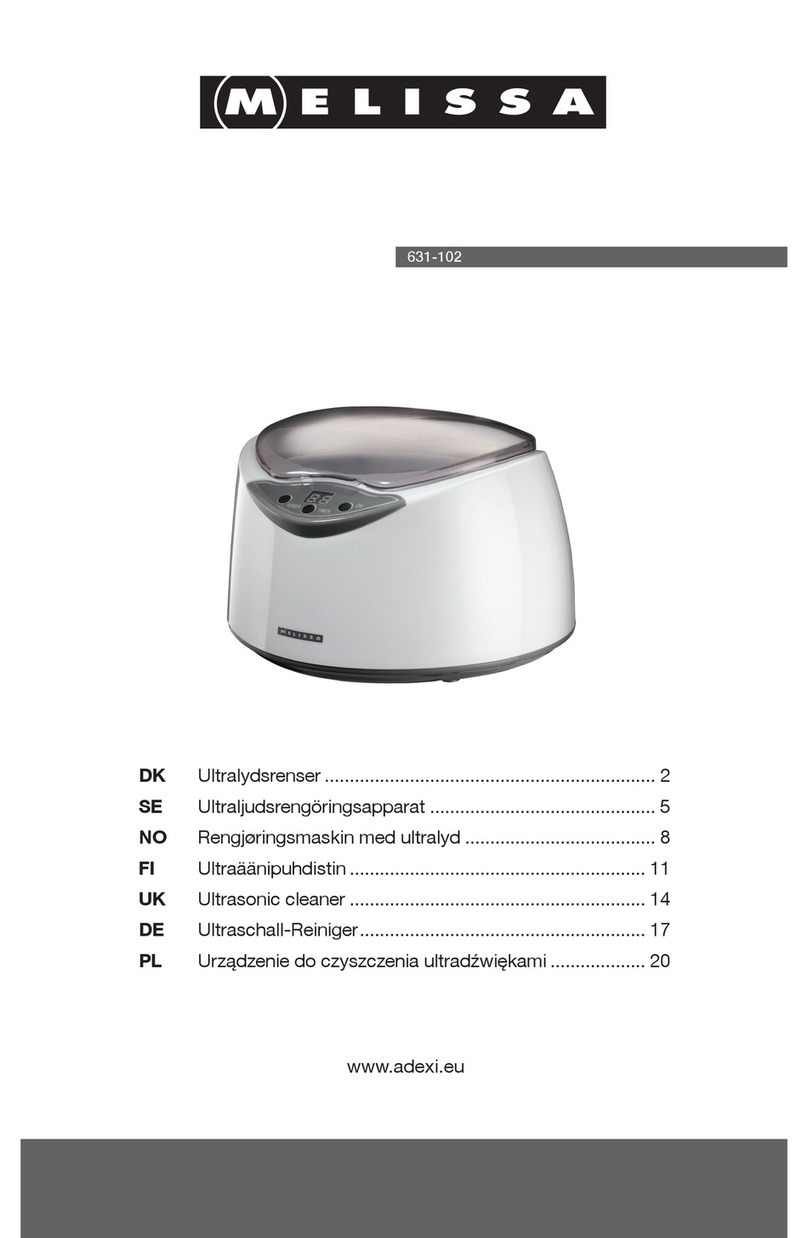
Melissa
Melissa 631-102 user guide

Belanger
Belanger DuraBlaster owner's manual
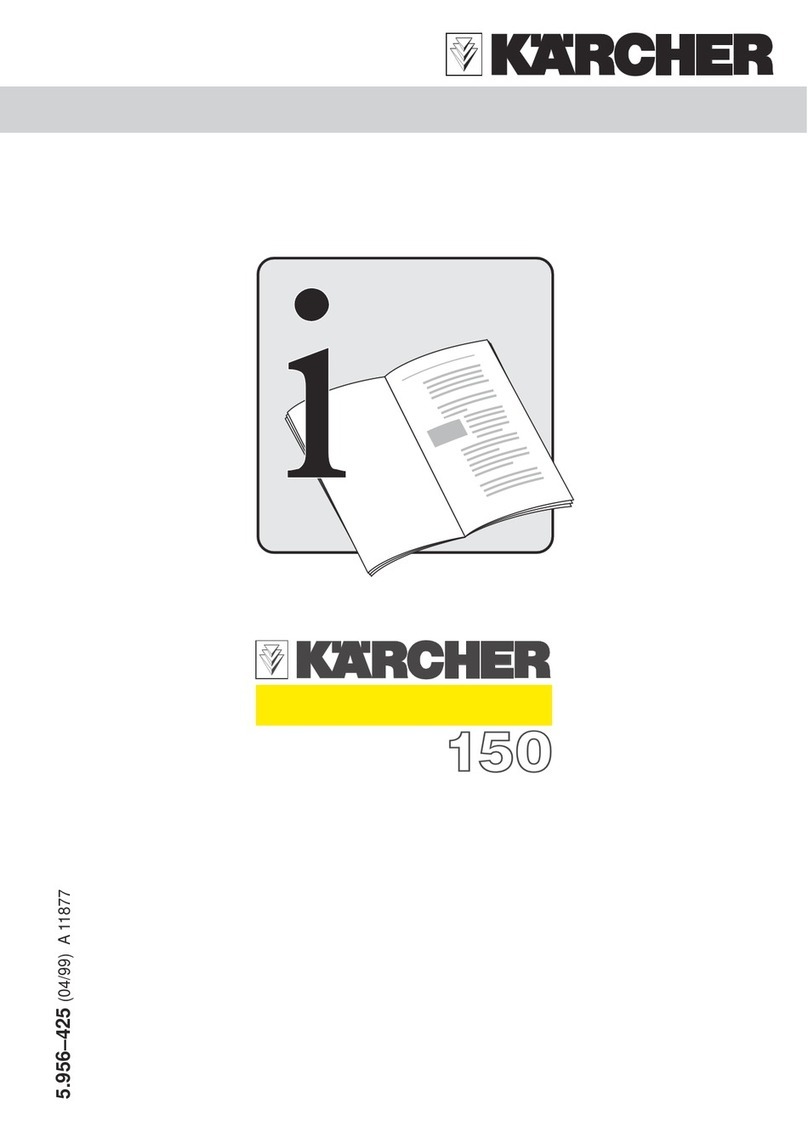
Kärcher
Kärcher 1.084 Series manual
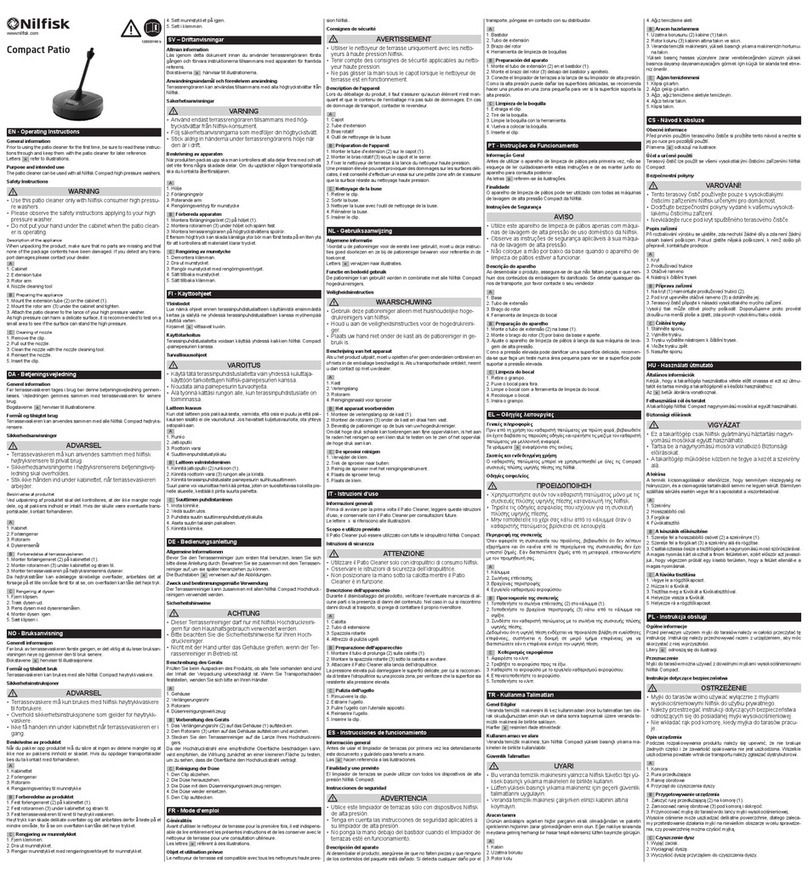
Nilfisk-Euroclean
Nilfisk-Euroclean Compact Patio operating instructions

Miele
Miele SEB 213 operating instructions
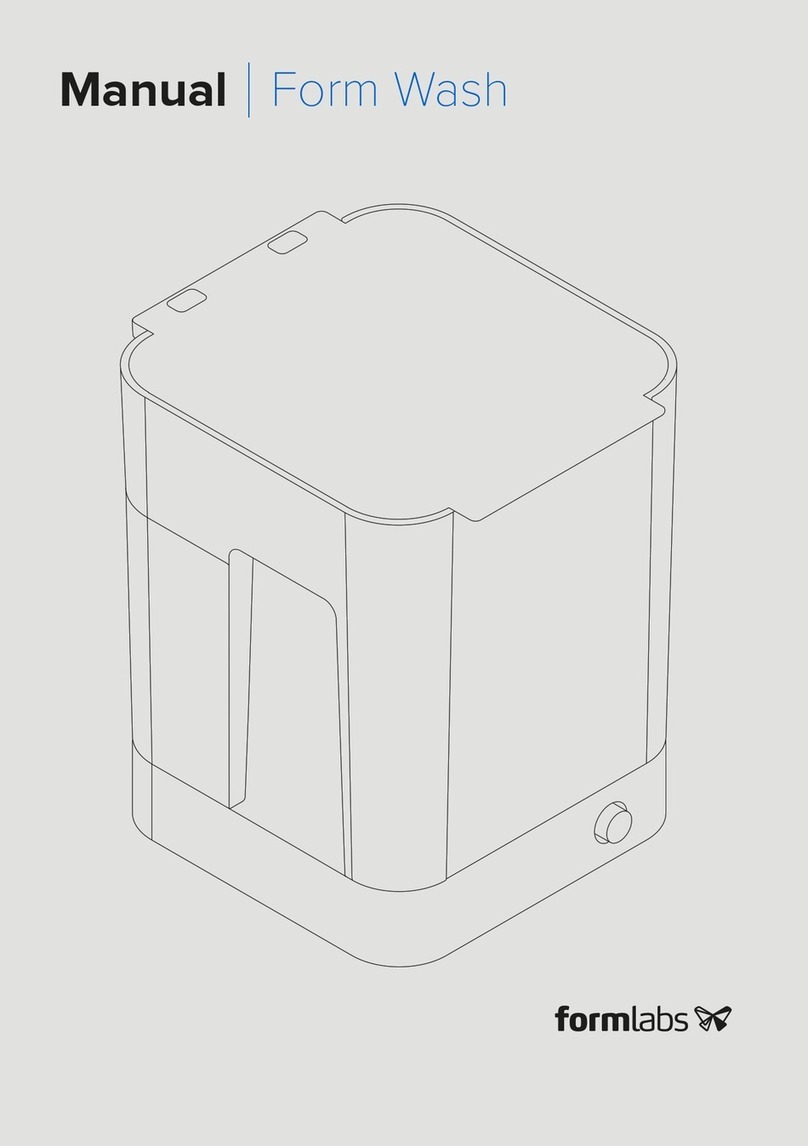
formlabs
formlabs Form Wash Installation and usage instructions
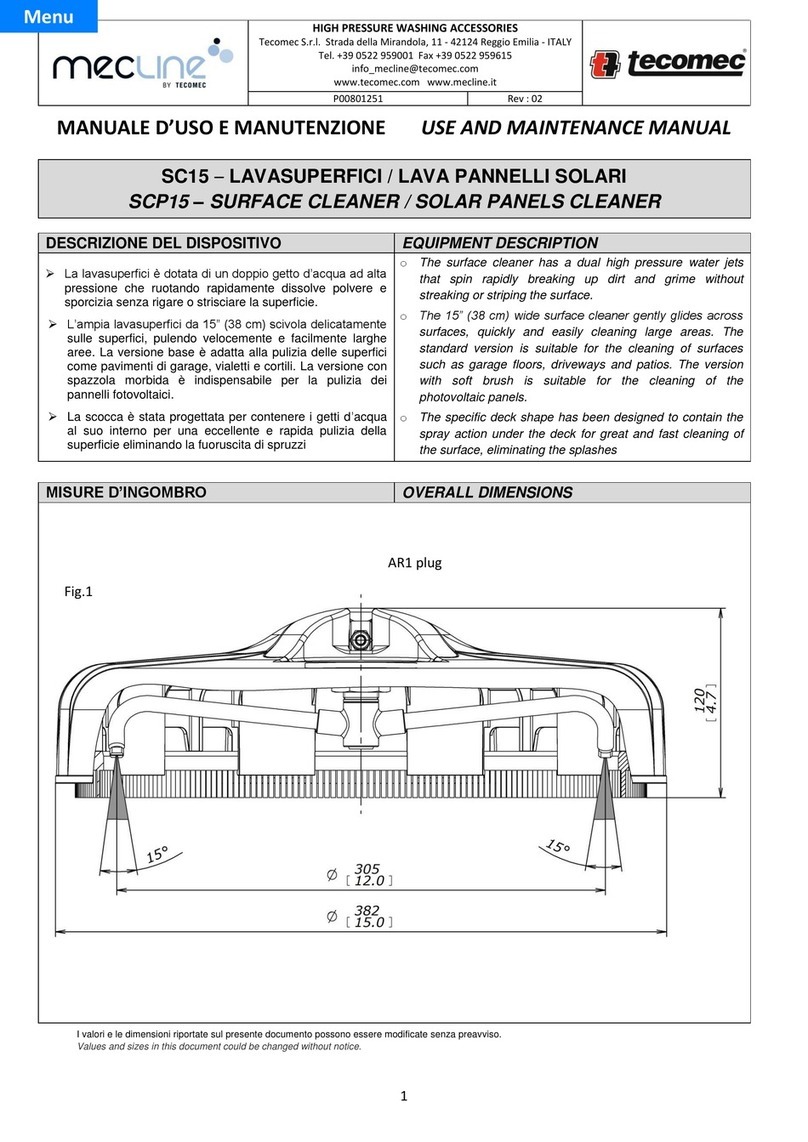
Tecomec
Tecomec Mecline SC15 Use and maintenance manual

Kränzle
Kränzle Round Cleaner UFO light operating manual
